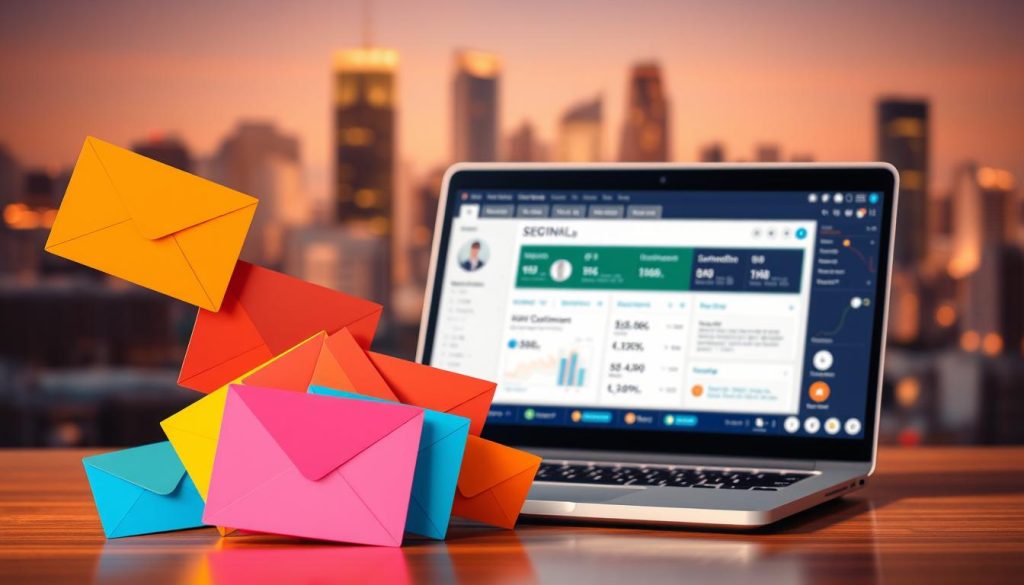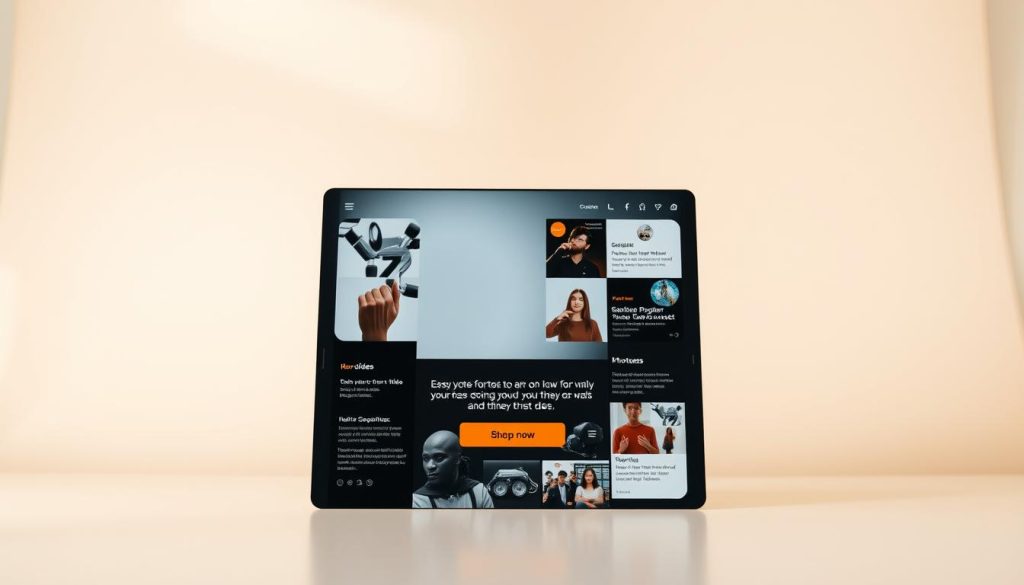Digital communication has revolutionized how companies connect with customers. At the heart of this transformation lies a powerful tool with a remarkable history. Ray Tomlinson sent the first electronic message in 1971, forever changing communication by introducing the « @ » symbol.
This potential was proven in 1978 when Gary Thuerk sent the first commercial message. That single effort to 400 addresses generated an incredible $13 million in sales. Today, this channel handles over 333 billion messages daily, a number expected to grow.
This comprehensive guide will show you how to leverage this direct channel. You will learn to turn prospects into loyal customers. We cover everything from strategy to advanced automation for your business.
The return on investment is undeniable, with an average ROI of 3800%. This makes it one of the most profitable strategies available. It reaches people directly in their inboxes, creating consistent touchpoints. For more on crafting successful email campaigns, our resources provide deeper insights.
Table of Contents
Key Takeaways
- Email marketing delivers an exceptional average ROI of 3800%, outperforming many other channels.
- It serves as a direct line of communication to your audience, integrating seamlessly into their daily routines.
- The scale is massive, with hundreds of billions of messages sent each day, proving its widespread effectiveness.
- This guide provides a foundation for both beginners and intermediate marketers seeking actionable strategies.
- You will learn to develop effective campaigns, utilize automation, and ensure compliance.
Introduction to Email Marketing and Its Benefits
The inbox serves as a private space where brands can establish meaningful dialogues with interested individuals. This direct approach eliminates intermediaries, allowing for personalized communication.
Understanding the Role of Email in Digital Marketing
Electronic communication functions as a powerful channel for reaching clients directly. It serves three primary purposes that drive business growth.
First, it builds awareness by making your company known to potential customers. Second, it establishes your brand as an industry expert. Third, it drives action that leads to sales.
The Impact on Sales and Customer Engagement
This approach creates consistent touchpoints with your audience. Research shows 90% of internet users check their primary inbox daily. Nearly half manage purchases through this channel.
The scalability allows for mass messaging while maintaining personalization. This creates individualized experiences that boost engagement and conversion rates.
| Objective | Primary Purpose | Key Benefit |
|---|---|---|
| Awareness Building | Introduce brand to new audiences | Expand reach and visibility |
| Image Positioning | Establish expertise and trust | Build credibility and authority |
| Action Driving | Generate sales and conversions | Direct revenue impact |
This method creates durable relationships that keep your brand top-of-mind. It supports the entire customer journey from prospecting to retention.
The Evolution of Email Marketing: From Beginnings to Today
The journey of electronic mail from a simple technical experiment to a cornerstone of modern business strategy is a story of remarkable innovation. This channel has continuously adapted to new technologies and user expectations.

Historical Milestones and Key Innovations
In 1971, computer engineer Ray Tomlinson sent the first electronic mail message. It was a simple string of text, but it introduced the « @ » symbol for addressing. This foundational moment created a new era for direct communication.
The first commercial use of this channel occurred in 1978. Gary Thuerk sent a message to 400 people about a new product. This single effort generated an incredible $13 million in sales, proving its massive potential.
Key developments shaped the landscape:
- The 1990s: The internet became available to the public. Marketers quickly saw the power of electronic mail for reaching a wide audience.
- Regulatory Changes: Laws like the UK’s Data Protection Act began requiring « opt-out » options. This established the need for permission-based practices.
- Modern Sophistication: From basic text, campaigns have evolved into personalized, automated journeys. This is a clear example of lasting adaptability.
Understanding this history shows why this form of marketing remains so effective today. Each milestone provided lessons that inform current best practices for engaging audiences.
Core Objectives and Strategy Behind Email Marketing
Understanding the core goals behind your email campaigns transforms random messaging into strategic communication. This approach serves distinct purposes throughout the customer relationship lifecycle.
Building Brand Awareness and Trust
The first strategic objective introduces your business to new prospects. Regular communication keeps your company top-of-mind among existing contacts.
Positioning yourself as an industry expert through valuable content establishes credibility. This trust makes recipients more likely to consider your solutions when purchase decisions arise.
Driving Conversions and Sales
The action-oriented objective focuses directly on motivating purchases. Effective campaigns communicate product information and compelling calls-to-action.
Strategic CTAs guide prospects through decision-making processes. Research shows 91% of customers prefer this channel for business communication.
| Strategic Objective | Customer Stage | Primary Focus |
|---|---|---|
| Awareness Building | Prospecting | Brand Introduction |
| Trust Establishment | Consideration | Expert Positioning |
| Conversion Driving | Decision | Purchase Motivation |
Balancing promotional content with value-driven messages builds lasting relationships. For deeper insights into crafting successful email marketing campaigns, our resources provide comprehensive guidance.
Segmenting and Personalizing Your Email Campaigns
Effective audience segmentation transforms generic messaging into highly relevant conversations that resonate with specific groups. As your contact list grows, it naturally becomes more diverse.

Creating Targeted Lists Based on User Behavior
Dividing your audience into smaller groups allows for precise targeting. You can segment contacts by demographics, lead source, or purchase history.
Behavioral data reveals engagement patterns and interests. This approach ensures each message speaks directly to recipient needs.
Leveraging Personalization for Better Engagement
True personalization goes beyond using names in subject lines. It involves analyzing navigation behavior and purchase history.
Companies can create individualized offers based on client preferences. This strategy dramatically improves opening and conversion rates.
With 85% of businesses using dedicated tools, proper segmentation prevents list fatigue. It complements broader strategies like remarketing campaigns for comprehensive audience engagement.
Choosing the Right Tools for Email Marketing Success
Your choice of software fundamentally shapes the effectiveness and scalability of your communication efforts. The right platform provides the foundation for successful campaigns that reach your audience effectively.
Specialized solutions handle critical functions that standard email clients cannot manage. They ensure proper delivery to inboxes rather than spam folders. This service dramatically impacts campaign performance.
Evaluating Software Options and Features
When assessing different services, consider your current contact volume and future growth projections. Also evaluate how many messages you plan to send annually. These factors determine which solution fits your business needs.
Leading platforms like HubSpot, Brevo, and Mailjet offer varying automation capabilities. Some provide over 130 industry-specific templates for quick campaign creation. These features save significant time compared to manual sending.
Built-in analytics track open rates, click rates, and engagement metrics. This data helps refine your marketing strategy over time. Proper subscription management ensures legal compliance across your site.
The right service transforms your marketing approach from basic outreach to strategic communication. It supports your entire digital presence and site objectives through reliable automation.
Designing Engaging Emails: From Layout to Call-to-Actions
The layout and design of your communications directly impact engagement rates and conversion success. Visual appeal determines whether recipients open and read your content or delete it immediately.

With 80% of users accessing messages from mobile devices, responsive optimization becomes essential. Seventy-three percent of companies prioritize this mobile-friendly approach.
Responsive Design and Mobile Optimization
Modern layouts must adapt automatically to different screen sizes. Smartphones and tablets require fast-loading, easily readable formats.
Testing across various platforms prevents display issues. This ensures images load properly and layouts remain intact.
Best Practices for Visual Appeal and Readability
Strategic use of white space improves content scanning. Clear hierarchy guides reader attention through the message.
Compelling calls-to-action should be placed prominently. These elements drive clicks and conversions effectively.
Creating templates streamlines the design process while maintaining brand consistency. Drag-and-drop editors allow anyone to produce professional results without coding knowledge. This approach complements broader strategies like landing page optimization for cohesive digital presence.
Automation and Data-Driven Tactics in Email Marketing
Data-driven approaches now power the most effective email marketing campaigns by leveraging user behavior patterns. These automated systems save significant time while delivering personalized content.
Automated messages deploy without manual intervention based on pre-established conditions. This efficiency allows businesses to maintain consistent communication with their audience.
Implementing Marketing Automation for Efficiency
Setting up automation requires defining templates and trigger conditions. User actions, time delays, or behavioral patterns determine when messages send.
Transactional automation handles operational messages like order confirmations and welcome emails. Marketing automation responds to relationship developments like whitepaper downloads.
Utilizing Analytics to Improve Campaign Performance
Measuring effectiveness helps identify which campaigns generate the most interactions. Key performance indicators provide actionable insights for optimization.
Conversion rates measure sales effectiveness while click rates assess engagement. Bounce rates evaluate list quality and unsubscribe rates reveal content relevance issues.
These data-driven tactics enable continuous campaign improvement. Marketers can refine strategies based on concrete performance data rather than assumptions.
Mastering Email Marketing: Proven Techniques to Convert Prospects
Strategic mastery of digital correspondence involves deploying different message types at precise moments in the customer journey. Understanding these formats transforms random sending into targeted communication that drives results.

Effective Use of Newsletters, Transactional, and Automated Emails
Businesses typically use two main categories of electronic messages. Time-sensitive communications follow your company’s rhythm, while automated sequences respond to user behavior.
Newsletters serve as regular touchpoints that keep your brand top-of-mind. They present company milestones, new features, and product use examples. Effective versions avoid generic subject lines and instead offer specific value propositions.
Campaign messages differ through concentrated marketing focus. These coordinated sequences typically consist of 3-10 messages around promotions like Black Friday or product launches.
Transactional communications fulfill operational functions that customers expect. Order confirmations and shipping notifications represent common examples. Welcome messages create critical first impressions by introducing your brand and setting expectations.
Despite sophisticated strategies, average open rates hover around 17.8%. This emphasizes the importance of compelling subject lines and sender names. For specialized execution, consider working with a freelance email marketer who understands these nuances.
Automated sequences respond to user actions like whitepaper downloads. They nurture prospects with relevant content that moves them toward decisions. Each message type serves a distinct purpose in the conversion process.
Navigating Challenges and Compliance in Email Campaigns
Maintaining effective communication channels involves overcoming two major hurdles: legal requirements and inbox placement. Both aspects demand ongoing attention to ensure your messages reach their intended audience while respecting privacy regulations.
Managing Deliverability and Avoiding Spam Filters
Deliverability represents whether your communications properly reach recipient inboxes. Technical factors like authentication protocols influence this success rate.
Behavioral elements also impact placement. High engagement rates signal quality to internet service providers. Regular list maintenance prevents spam folder routing.
Adhering to Legal Standards and Data Protection Regulations
Global regulations protect consumer personal data. The GDPR requires explicit opt-in consent for European contacts. Businesses must document this authorization clearly.
In France, CNIL enforces these data protection rules. The commission audits companies and imposes penalties for non-compliance. Proper unsubscribe mechanisms are mandatory.
| Factor Type | Key Elements | Impact on Campaigns |
|---|---|---|
| Technical | Authentication, Infrastructure | Inbox Placement Rate |
| Behavioral | Engagement, Complaints | Sender Reputation |
| Legal | Consent Documentation | Compliance Status |
Following best practices improves your open rate significantly. Avoid trigger words in subject lines and maintain updated contact lists. These strategies enhance overall campaign performance.
A/B testing identifies deliverability issues before full deployment. Compare different sender names and content formats. This proactive approach protects your sending reputation.
Conclusion
Building lasting customer relationships through targeted inbox communication remains essential for modern commercial success. The strategies outlined demonstrate how email marketing delivers exceptional returns when implemented correctly.
Your business can transform casual contacts into dedicated clients by providing valuable information about your products and services. This approach builds loyalty while driving purchase decisions.
Taking action to implement these techniques positions your company for growth. Choose the right service and create content that resonates with your specific audience.
The journey from prospect to loyal client becomes smoother with strategic electronic communication. Start applying these proven methods today to see measurable improvements in your marketing results.
FAQ
What is the primary benefit of using a newsletter in a digital communication strategy?
A newsletter serves as a powerful tool for maintaining regular contact with your audience. It helps build brand awareness, nurture leads, and keep your products or services top-of-mind, which can drive conversions over time.
How can I improve my campaign’s open rate?
Focus on crafting compelling subject lines that spark curiosity or offer clear value. Additionally, segmenting your contact list to send relevant messages and ensuring you have permission to communicate are critical for boosting your open rate.
What are the key legal considerations for sending commercial messages?
It’s essential to comply with regulations like the CAN-SPAM Act. This includes providing a clear way for recipients to opt-out of future communications and honoring those requests promptly. Always be transparent about how you use personal data.
Why is marketing automation important for efficiency?
Automation streamlines your outreach by triggering messages based on specific user actions, like a welcome series for new subscribers. This saves time, ensures timely communication, and helps guide prospects through the sales funnel without manual effort.
What makes a call-to-action (CTA) effective?
An effective CTA is clear, action-oriented, and creates a sense of urgency. Use contrasting colors and concise language to make it stand out, directing the reader toward a specific next step, such as « Shop Now » or « Download Your Guide. »
How does personalization impact engagement?
Personalization, like using a contact’s first name or recommending products based on past behavior, makes the recipient feel valued. This tailored approach significantly increases engagement, click-through rates, and the likelihood of a purchase.





